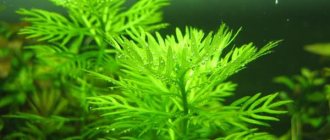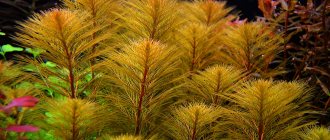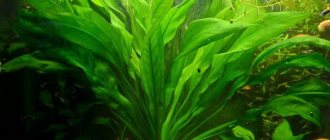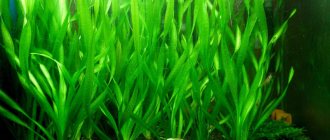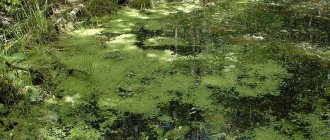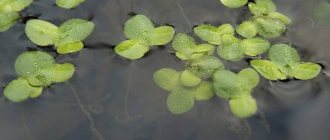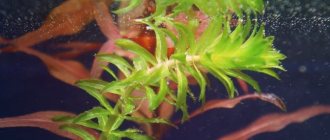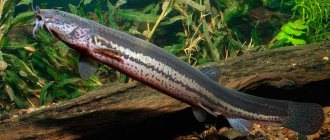An unusual perennial that grows in water. Belongs to the family “Chastukhovae”, prefers temperate and tropical climates. The genus “arrowhead” has about 40 species. In nature it grows on river banks, as well as along ponds and lakes.
Author of the article
Maxim Sverchkov
Professional biologist and breeder with extensive experience and experience.
In Rus', the spirit responsible for protecting the marriage bed was depicted by the Slavs as a golden cat holding the stem of this plant in its teeth. Arrowhead is also popularly called bogwort and shilnik.
Arrowhead has found wide application in the decoration and decoration of aquariums, as well as artificial reservoirs. Arrowhead looks great in a pond.
Thanks to the plant's ability to change leaves, aquarists can create a variety of underwater herbals.
Description
Arrowhead is a perennial plant that grows primarily in an aquatic environment. The culture belongs to the Chastukhov family. Another name for the species is swampweed, which is associated with the peculiarities of growing the plant. The culture is a small herbaceous plant with long stems and foliage that are completely or partially submerged under water. Due to the characteristics of its growth, bogweed is classified as a hydrophyte plant. The height of individual bushes is about 1.5 meters.
The swamp has a developed, but rather short rhizome that clings to the bottom or muddy soil. The roots are light, branched, mainly consisting of lateral and adventitious processes. Stems emerge from the base of the root collar. The shoots are triangular in shape, ranging in size from 20 cm to 1.1 meters, most often completely located under water, less often they partially peek out from the shallow water.
The stems of the plant are single, light green in color. In addition to the elongated main shoots, lateral shoots also extend from the base of the root collar, which often form underground tubers, which are later used for propagation of the crop.
The structure of the foliage is also unusual on the plant. The marsh plant has several types of foliage, varying in shape, structure and composition. A feature of the culture is a change in structure, depending on the location of the culture in the water or on the shore. If the bogweed grows in the center of a reservoir, it consists only of basal underwater foliage, and the spruce tree is located near the shore, then it contains only floating foliage. Radical leaves extend from the base of the root collar, having an elongated shape and forming a basal rosette. They are always located under water, not exceeding the boundaries of the water. The leaf blades are quite thin and thread-like. The length of such threads reaches 1.5 meters.
Floating foliage is larger. The elliptical shape of such leaves allows them to float on the surface of the water. The surface of the foliage is coated with a special lubricant that prevents the foliage from getting wet and immersed in water. The surface foliage of the swampweed is divided into several parts, each of which is arrow-shaped. The surface foliage is about 25 cm in diameter.
Flowering of arrowhead begins in early summer, when clusters of 3-4 flowers collected together appear on a long single peduncle. The flowers are quite large, about 5 cm in diameter. The flowers consist of a green core, around which there are 3 white-pink petals. The flowers are located superficially above the water, so they are pollinated by insects. The flowers retain their decorative effect throughout the summer.
After flowering, fruits begin to ripen in place of racemose inflorescences. Arrowhead fruits are represented by small achenes that float on the surface of the water. After the fruits ripen, they are separated from the peduncle and spread with the help of the current. The seeds are washed ashore, where they remain for the winter at the bottom of shallow water. In spring the plants sprout.
Spreading
Most species of arrowhead are common in America. Only a few species of bogweed are found in Russia. The wild crop also lives in Central and East Asia. In our country, bogweed is more often found as an ornamental and economic crop, used as a culinary or medicinal plant. You can find wild varieties in Russia in the Primorsky Territory, along the banks of the Volga and in the lower part of the Don. In the northern regions of the country, only two species of bogweed grow.
Arrowhead lives mainly on the outskirts and inside swampy areas. You can meet the swampweed along the banks of various natural and artificial reservoirs. An important condition for the growth of the crop is heavy loamy soils or gley, peat soils.
Habitat
In the wild, this plant of the Chastukhov family can be found in the tropical regions of Asia, as well as in the southern and central states of America. This plant loves marshy areas and can grow near slow-moving bodies of water.
In its natural environment, this flower forms underwater and above-water long-petioled leaves. In an aquarium, the surface leaves of the plant can only develop in conditions of long daylight hours - at least 12 hours.
In the garden, arrowhead is used to decorate the coastal zone of artificial reservoirs. Sagittaria goes well in group plantings with other plants in the aquatic environment. It is used to create various styles - classic, exotic, etc.
Types and varieties
Arrowhead has a rich species composition. The plant has more than 35 different species, which have their own characteristics and habitat. Many of the species are grown today as ornamental cultural representatives.
Common arrowhead
The most popular type of plant that lives in an aquatic environment. You can more often meet the culture inside a reservoir than near the shore. The appearance of the swamp is no different from others. The basal underwater leaves are thin and form a rosette. Some parts of the plant, including inflorescences, grow on the surface of the water. The difference between the variety is the presence of large white-pink inflorescences that appear by mid-summer.
Subulate arrowhead
The natural habitat of this plant is the northern part of America. The culture has good resistance to temperate and northern climates. This is a perennial crop that has a poorly developed rhizome, which is attached to the bottom of the reservoir by adventitious parts. The peculiarity of the culture lies in the thin green underwater leaves, on the surface of which bright light veins are visible, distinguishing this species from others. The plant is widely used in decorative culture to create picturesque aquariums.
A feature of the culture is that it grows mainly in warm water. The active growing season takes place at a water temperature of about 26 degrees. Despite this feature, the crop tolerates sudden changes in water and air temperatures in summer quite easily. The swamp is unpretentious to the structure and composition of water. However, when grown under cultural conditions, in order to maintain the decorative appearance and correct shape of the crop, regular fluid replacement and cleaning are necessary. Arrowhead is light-loving; for normal development, the crop requires several hours of direct sunlight.
Dwarf arrowhead
A small plant whose height rarely exceeds half a meter. The peculiarity of this annual is its ability to form bushes and thickets, consisting mainly of arrow-shaped floating forms of foliage. The plant is cultivated in home aquariums and containers about 100 liters deep. It is a fairly cold-resistant plant that can withstand temperatures up to 15 degrees. The only condition for cultivating swampweed is the need for constant water replacement. Arrowhead does not tolerate even slight contamination of the liquid. When turbidity and sludge appear at the bottom of the aquarium, the plant quickly withers and collapses.
You might be interested in: Salvinia
The culture is considered light-loving. In order for the culture to feel optimally in the aquarium, the sun must hit it at least 5 hours a day. If this condition cannot be met naturally, special lamps are used to replace the light source. Since arrowhead has practically no root system, it is planted in an aquarium on sand or loose peat so that the plant can cling to the bottom.
Eaton's Arrowhead
A plant that is found in wild and cultivated environments. Under natural conditions, the culture forms thickets. The peculiarity of the plant is its ability to adapt and develop in accordance with the size and volume of the reservoir. The plant is small in size, the length of thin thread-like underwater leaves collected in basal rosettes is, on average, about 0.2 m. The bright large snow-white inflorescences that appear on the crop in June also make the arrowhead decorative. Despite its decorative and unpretentious cultivation, bogweed is an annual plant, so it quickly loses its shape and structure.
The plant lives only in warm environments; the water should not be below 19 degrees so that the plant can develop normally. When cultivating in aquarium conditions, it is important to constantly maintain the purity of the liquid and replace the water at least once a week. In addition, the crop becomes decorative if there is a water filtration system.
Arrowhead rigidifolia
In its natural environment, this species can be found in South America. The plant is distinguished by bright underwater leaves, as well as short leaves with a pointed leaf shape. The leaves of this species are quite dense, fleshy, and hard to the touch. The plant is small in size, does not exceed 30 cm in height. Unlike other species, the roots of this crop are well developed, so arrowhead easily takes root in almost any soil. In addition, this species does not get along with other inhabitants of the aquarium, therefore it is cultivated mainly as a separate plant.
Sagittaria latifolia
The plant is found in Asia and America. It is used mainly as an ornamental crop. The peculiarity of the structure of the bogwort is the basal rosette, consisting of long and dense leaves of an elongated shape. On average, about 13 leaves are formed on one plant. The foliage has a visible network of visible veins. Swampweed is a fairly tall crop, up to 40 cm high. At the same time, the leaves do not exceed 20 cm in length. The peculiarity of the arrowhead is the width of the leaves, which often exceeds 4 cm. The perennial blooms quite rarely, but the flowers retain their decorative effect for a month.
The inflorescences are racemose, each raceme contains about 20 flowers, reaching 3 cm in diameter. The flowers are snow-white and float on the ground. At a water temperature of about 22 degrees, the flowers remain decorative for 20 days.
Floating arrow leaf
A fairly tall herbaceous perennial that lives mainly in stagnant water. In the wild, the plant is found throughout Europe and Germany. The culture has a fairly dense rhizome, which is attached to the bottom of the reservoir. Transparent, thin leaves of a light green color emerge from the root collar. The leaves are arrow-shaped and float on the surface of the water.
The crop blooms in mid-summer. Clusters of white flowers appear on the crop. The inflorescences are racemose, formed by small flowers with a green core and three petals. The fruits are formed by the beginning of autumn.
Arrowhead trifoliate
Perennial, reaching a height of one meter in length. It is found naturally in the USA and Central Asia. The plant has a bare stem that is only partially submerged in water. The rest of the culture is above the water in an upright position. The leaves of this species are airy and have a rounded, arrow-shaped shape. The peculiarity of the swampweed is the formation of a racemose inflorescence formed by three completely white flowers.
The culture today is an endangered species, therefore in many countries it is listed in the Red Book. In some countries, the crop is grown as an ornamental, as well as for economic purposes. The crop is not grown in the home environment, since it requires a large area to grow.
Why doesn't the arrowhead grow?
There could be several reasons:
| Growth factors | Possible reasons |
| Illumination | Lack of light. |
| Priming | Too large or too small, or poor nutrient composition. |
| Neighbours | Unsuitable tank mates. |
| Water quality and composition | Lack of regular replacement. |
| Temperature | Low temperatures slow down growth and leaves become smaller. |
| Turbidity of water and abundance of organic particles | The formation of plaque on the leaves leads to a slowdown in metabolic processes in the leaves and subsequent death. |
Signs of inappropriate care are significant changes in the color of the leaves of the plant:
- The appearance of a yellow tint will indicate a lack of such an important trace element as iron. To replenish it, you will have to regularly feed it with special iron-containing preparations or iron sulfate (approximately 1.5 to 2 grams per 100 liters of water).
- Red shades warn of too bright lighting in the aquarium, and for quite a long time. This is a signal to reduce and reduce light exposure by replacing light bulbs with less powerful ones.
- The presence of a pale color is a sign of a lack of macro- and microelements in the water.
Do not forget to periodically trim and thin out these plantings so that in a few months they do not fill the entire container with “impenetrable” thickets.
Care
Caring for arrowhead is quite simple. The plant is undemanding to living conditions. However, culture cannot be completely neglected either. Subject to basic care rules, the crop retains its decorative properties and remains decorative throughout the season.
Landing place
To plant crops in aquariums, choose places with diffused sunlight. When planting a crop in artificial reservoirs, plant seedlings are lowered to the bottom near the shore. In order for the arrowhead to develop normally, it must receive regular sun, but not midday sun and only a few hours a day.
Arrow leaf planting
It is not difficult to purchase swampweed seedlings. As a rule, plants are found in nurseries and stores. When purchasing, it is important to determine the quality and health of the plant. Thus, a normal arrowhead has no spots on the foliage, the leaves look fresh and healthy. They also pay attention to the rhizome - it should be branched and light-colored, and free from areas of rot and mold.
The swamp plant is planted on the bottom of an artificial reservoir or aquarium. Planting is carried out in late spring or early summer, when the water temperature is constantly at least 18 degrees. Cultivation is carried out to a depth of about 10 cm of soil. In a pond, the depth should not exceed 1 meter so that the plant can produce superficial leaves and inflorescences.
Planting of seedlings is carried out in a warm, sunny climate. During cultivation, a hole of about 5-10 cm is dug at the bottom of the reservoir, after which the plant is placed there. After planting, the hole is dug in and compacted so that the plant is not carried away by the underwater current. If several arrowheads are planted in one pond or aquarium at the same time, a distance of about 30 cm is maintained between the crops.
Illumination
It is important for the crop to receive sunlight during the day. However, arrowhead gets along optimally in a diffused and semi-shaded pond or aquarium. Some varieties do well in bright, open areas. If there is insufficient lighting, the arrowhead becomes gray and lethargic, the leaves and stems droop and cease to function normally.
You might be interested in: Vodokras
soil mixture
For planting most types of arrowhead, light sandy soil is chosen. Since the rhizome of the crop is poorly developed, the arrowhead clings to small stones. Small pebbles are also suitable for cultivating arrowhead. For certain types of arrowhead, turf soil mixed with sphagnum peat is suitable. Organic fertilizers are added to the soil at a rate of 1:5 of the mixture composition.
Temperature
Arrowhead is a heat-loving plant, the optimal development temperature of which is considered to be 22-26 degrees. However, in its natural environment, the swampweed feels optimal in both cold and hotter environments. Arrowhead also adapts well to temperature changes.
Watering
If the crop is grown in open ground or on the banks of a river, it is watered regularly and abundantly. It is important to understand that the soil in the place where arrowhead is cultivated should never be dry. Any, even minor drought can cause the death of the plant. If the crop is grown in pots, there should be no holes at the bottom of the containers. In addition, there is no drainage layer in the pot. When watering such plants, the container is completely filled with water, covering the layer of soil to the brim.
Fertilizer
Arrowhead is quite unpretentious to cultivation conditions and easily survives conditions of low amounts of nutrients. However, in this case, the culture quickly loses its decorative effect. In order to enhance the growing season, increase the number of flowers and their flowering, complex mineral fertilizers are added to the soil. They use complex fertilizers that are sold in nurseries and stores.
Trimming
Conducted several times per season. The crop is subjected to sanitary pruning, as well as formative pruning. When pruning in spring and autumn, damaged and dead parts of the plant are removed. In the spring, dry leaves that did not survive the winter are also pruned.
Varieties of arrowhead
About 40 species of arrowhead are found in natural conditions. Some varieties have decorative properties. are especially common when constructing reservoirs and aquariums :
- Ordinary. Arrow-shaped above-water and thread-like underwater leaves are bright green in color. The leaf blade can have a size from 7 to 16 cm. The plant is easy to recognize by its racemose white inflorescences that appear in July.
- Karlikova. Used as an aquarium decoration due to its small size. An adult plant is about 10 cm in height.
- Subulate. This species is distinguished by narrow leaves from 7 to 20 cm long. It is allowed to plant it not only when completely immersed in water, but also along the edges of reservoirs. Its unpretentiousness and resistance to pruning of unnecessary parts of the bush have made it an indispensable plant for aquarists.
- Floating. This variety is distinguished by a rosette located at the base and a long stem. It produces oval, arrow-shaped leaves along its entire length. In nature, it is found near river banks and in shallow waters.
When growing any variety of arrowhead, you should follow the rules of propagation, planting and care. Swampweed is rarely grown from seeds due to the lack of such a need.
Recommendations for growing arrowhead in an aquarium
When cultivating swampweed at home, ensure proper preparation of the planting site in advance. It is important to study the features of the neighborhood of arrowhead with other underwater crops, since many types of swampweed do not take root with other plants. After placing the mireweed in the water, the aquarium is placed in such a way that the sunlight or lighting lamp is directed vertically above the culture. It has been proven that with side lighting, stems and leaves become thinner and stretch out, and decorativeness suffers.
At the bottom of the aquarium there must be a high-quality layer of soil, the thickness of which is at least 5 cm. Silty soil, preferably river soil, or small pebbles with sand are suitable for an aquarium. Cultivation is carried out to a depth of about 3 cm. The basic rule when cultivating swampweed in an aquarium is a constant change of water, as well as regular filtration and ventilation. The culture easily takes root in hard water and high acidity.
Despite the fact that aquarium plant varieties often grow large and strong rhizomes, the culture produces poorly developed tubers. Therefore, if a decision is made to replant a plant, do so with extreme caution. When replanting, it is recommended to replant the plant along with part of the soil to speed up the recovery process.
Planting secrets
Planting all types of sagittaria requires caution in handling planting material, as they have a rather fragile root system. At the same time, they do not like the specimen’s neck to be buried deep in the sand; it is better to leave it on the surface. When growing, use high-quality river sand and regular fertilizing. The average planting depth is 2-3 cm.
Experts also recommend first placing a lump of silt or clay taken from an aquarium under the root, which helps the plant adapt more quickly to a new location. It is also recommended to pre-use organic fertilizers in the form of a peat ball in the planting areas.
A change of environment can cause some of the swampweed leaves to fall off due to stress. There is no need to worry: everything will return to normal very soon.
Wintering
When cultivating a plant in open ground or a pond, it is important to prepare the arrowhead for frost in a timely manner. With the onset of frost, the tubers formed during the season are separated, and the entire above-ground part is also removed from the plant. The resulting tubers are immediately placed in warm water so that the soil remaining on the tuber does not fall off. After this, a thin layer of sand is poured onto the flat surface of the box, on which the tubers are then placed. The sand must be moistened. The tubers are again sprinkled with sand. In this way, you can lay several rows of tubers. It is important that the sand in the box is constantly moist, since dried out tubers cannot survive without water for more than 3 hours.
If there is no need to propagate the crop for the next year, the entire above-ground part of the arrowhead is left, and the underwater part is not touched. In this form, the crop will easily survive any frost. In spring, buds quickly appear on the crop, which give impetus to the new growing season.
Benefit
This plant contains a significant amount of starch, so if you eat dry tubers wisely, you can get some benefits.
Arrowhead has the following effects:
- astringent;
- wound healing;
- normalizing digestion;
- antiulcer;
- anti-inflammatory.
Reproduction
There are several ways to propagate awl. Depending on the need to obtain one or several copies, one of the proposed methods is used - dividing the bush, seed propagation and germination of tubers.
By division
The vegetative method of propagation is considered the only possible way to obtain new individuals from decorative and hybrid terry varieties of arrowhead. The method of dividing a bush is the simplest and fastest. This is due to the fact that new side bushes appear on the plant every year, which are easily separated from the mother plant and cultivated in a new place. The procedure is carried out in spring or late autumn. When replanting, it is important to prevent young plants from drying out by placing them immediately in a moist environment.
Tubers
In autumn, rooted bulbs can be found at the ends of young shoots, which are planting material for new individuals. To obtain a plant, in November the tuber is separated from the mother plant, after which the tubers are placed in damp sand for the winter. Planting is carried out in the spring, when the water warms up enough.
Seeds
Seed propagation is practically not used by gardeners, since the method is considered the most complex and costly. The plant is easy to propagate using the above methods. The seed propagation method is used only by breeders who want to obtain a new species or variety of crop.
Diseases and pests
Since swampweed is an aquatic plant, when grown in clean water, it is practically not afraid of any pathologies. However, when the culture is kept in an artificial reservoir on the street or in a pot, certain pathologies may arise, which are eliminated at their first manifestation. Among the main problems concerning the swampweed are:
- Damage to the plant by algae that envelop the arrowhead and stems, and also affect the rhizome of the crop;
- In summer, snails may appear on the surface of the leaves and are not averse to nibbling on the delicate leaves of the arrowhead;
- Slow growth and development - the main reason for this condition is considered to be cold water or poor-quality, heavy soil;
- With poor-quality and dirty water, the culture is quickly destroyed and covered with plaque;
- When there is insufficient lighting, the plant begins to stretch upward, the decorative appearance and structure of the bush suffers;
- When there are few nutrients and minerals, arrowleaf turns yellow or pale.
You may be interested in: Lotus
When crop care is normalized, such problems usually do not arise. Arrowhead decorates an aquarium or pond with its blooms.
Application
Arrow leaf is used not only as an ornamental plant. The chemical composition of the culture allows it to be used as a remedy against certain human diseases, as well as as a delicacy. The plant is rich in starch and tannins. In addition, the plant contains various microelements and acids, which allow the crop to be used for medicinal purposes. We will tell you more about the use of swampweed below.
In cooking
Many lovers of delicacies cannot pass by without trying the taste of arrowhead. Mainly arrowhead roots are used as nutrients. Dried rhizomes and tubers are used dry. Some people consume the roots directly raw. In addition, the rich and beneficial chemical composition of the plant allows you to prepare various dishes from arrow leaf, as well as add the plant to soups and meat dishes. The roots of the bogwort taste like nuts; when baked, the taste takes on potato notes, and when boiled, it takes on a pea flavor. Cooking swamp takes the same amount of time as preparing regular human dishes. In some countries, bogwort tubers and roots are dried, ground into flour, and various baked goods are made from it. The starch contained in the plant provides the dish with a viscous consistency. Therefore, mashed potatoes and jelly are prepared on the basis of tubers.
Baked swampweed
To prepare baked arrowhead tubers, thoroughly wash and clean the rhizome from any remaining soil. Most often, dried tubers are used, which are finely chopped and added as a side dish to baked meat. Tubers give the dish a pleasant aroma and unusual taste. In addition, dry tubers are often ground into flour and then baked with various combinations of vegetables, potatoes and meat.
Swampweed puree
Since arrow leaf contains an abundance of starch, exceeding even the composition of potatoes, side dishes are made based on the culture, one of which is mashed potatoes. To prepare the puree, peeled tubers are boiled in salted water, then mashed to the required consistency.
In medicine
The chemical composition of bogwort determines the widespread use of the plant in folk medicine. Based on the culture, various decoctions and infusions are obtained that can eliminate the wound surface, help stop bleeding and fight infectious skin pathologies. The plant is used as an astringent for diarrhea and gastrointestinal irritation. The plant has been proven to be effective in the fight against peptic ulcers and helps eliminate inflammation and pain.
When losing weight
While losing weight, taking arrow leaf will not bring the desired result, since the culture does not contain substances that help speed up metabolism or burn fat. However, the plant is effectively used to cleanse the body and skin of accumulated waste and toxins.
At home
In some countries, swampweed is used as food for livestock. In addition, the culture is used as a nutrient for underwater inhabitants and birds living in ponds.
Most often, swampweed is used as a means to decorate landscape design. The culture is used as a way to decorate home aquariums. In addition to its unusual appearance, arrowhead is a nutrient for aquarium animals.
How to decorate a pond
Growing the plant in a pond has decorative value. Arrowhead is planted along the banks and in the center of the pond, as a component with other crops. In addition, the plant looks impressive when it forms thickets. The flowering of arrowhead is also of great importance in decorating a pond. The advantage of choosing this plant as a landscape decoration is the possibility of cultivating arrowhead in the coastal zone and on land, including if the artificial reservoir has dried up.
In cosmetology
Some skin care products are made from swampweed. The enzymes contained in the plant are used as anti-aging components, as well as for tightening facial skin. In addition, compresses and masks are made from the decoction, which give it freshness and help fight and discolor scars and age spots on the body. It is also useful to use compresses for swelling, as well as for dark circles under the eyes.
Preparation and storage
Harvesting of plant parts is carried out in spring or autumn. After collecting and trimming the rhizome, it is washed under warm running water and cleaned of any remaining soil. The root part of the plant is cut into small thin pieces, then laid out in one layer to dry. Drying should take place in a dark, well-ventilated place. To obtain flour, dried roots are crushed in a blender or ground mechanically. As a rule, arrowhead leaves are not dried, since all their benefits are contained in the fresh part of the crop.
Interesting Facts
It has been proven that arrowhead tubers contain several times more nutrients and minerals than potatoes. Swamp tubers do not contain an abundance of watery substances, like potatoes, so they contain one and a half times more starch, sugars, and tannins. However, the plant is rarely used as a main dish, because, unlike potatoes, boiled arrowleaf leaves a bitter taste in the mouth. The plant is used mainly as an additive to baked goods or first courses.
Harm or contraindications of arrowhead
- For severe diseases of the digestive system with frequent exacerbations, it is recommended to consult a doctor before systemic use of the product.
- The plant is prohibited for women during pregnancy and young children under 6 years of age.
- Contraindications are individual intolerance and allergies.
- Patients with diabetes, obesity, and diseases of the cardiovascular system due to the high content of sugars should not use arrow leaf.
